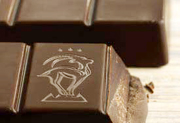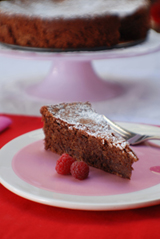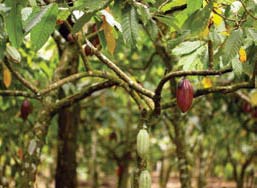|
With Valentine’s Day on the horizon, February ushers in a frenzy of giving, receiving and generally indulging in chocolate. Thanks to a growing focus on environmentally and socially responsible chocolate production, we can shower our loved ones with goodies, and do a little good for the planet at the same time.
Chocolate is produced from the fruit of the cacao tree, grown in the fragile rainforests of Central and South America. In order to thrive over the course of generations, cacao trees require shade. This means they grow best when interspersed among other, larger vegetation. This diversity fosters a naturally complex ecosystem, home to a wide variety of plants, insects and animals. Such complex environments are inherently hardy; more resistant to disease, and more able to withstand harsh climate fluctuations than homogeneous ecosystems. In other words, when raised using traditional farming methods that work in harmony with nature, chocolate is a model sustainable crop.
The trouble begins when industrial plantation-style operations strip the natural landscape to plant row upon row of isolated cacao trees. Although these methods yield huge crops—and cheaply—in the short term, over time they devastate the rainforest habitat, exhaust the soil and leave the cacao trees dangerously vulnerable to disease. To say nothing of the human impact on local economies and the destruction of traditional farming communities. Some speculate that if left unchecked, plantation farming methods could damage our planet’s chocolate-growing regions beyond rehabilitation, leaving the much-adored confection in woefully short supply.
Fortunately, many chocolate producers aren’t willing to see that happen. The sustainable chocolate industry has been gaining momentum for 10 years or more, working with worldwide environmental and fair-trade organizations to help support and revitalize smaller-scale, traditional cacao farming.
San Francisco’s own acclaimed Scharffen Berger Chocolate has been a leader in this area, joined by other popular brands including Dagoba, Green & Blacks, Chocolove and many others. Today you’ll find a wide selection of sustainably produced chocolate in any natural foods or high-end grocery store, and indeed even many mainstream grocers are carrying eco-conscious options.
A word of caution for responsible shoppers: Since many labeling terms in the chocolate industry aren’t clearly defined or strictly regulated, it’s not always easy to be sure about the values and production methods behind that tempting bar. Check the company’s web site to get informed.
Will you pay more when shopping green? Probably. But you’ll get your money’s worth, and not only in terms of peace of mind. Sustainable chocolate also tend to be among the highest in quality (and therefore most delicious!), because it’s made by companies with vision and integrity that value traditional, artisan food production.
Whether you’re whipping up a mousse, delivering a valentine or simply quelling an afternoon craving, sustainably produced chocolate is a treat that satisfies on many levels. As if you needed another reason to indulge.
NOTE: Many thanks to our San Francisco neighbor, Scharffen Berger Chocolate Maker, for sweetening our Valentine’s Day pages with two of their most popular recipes.
|




